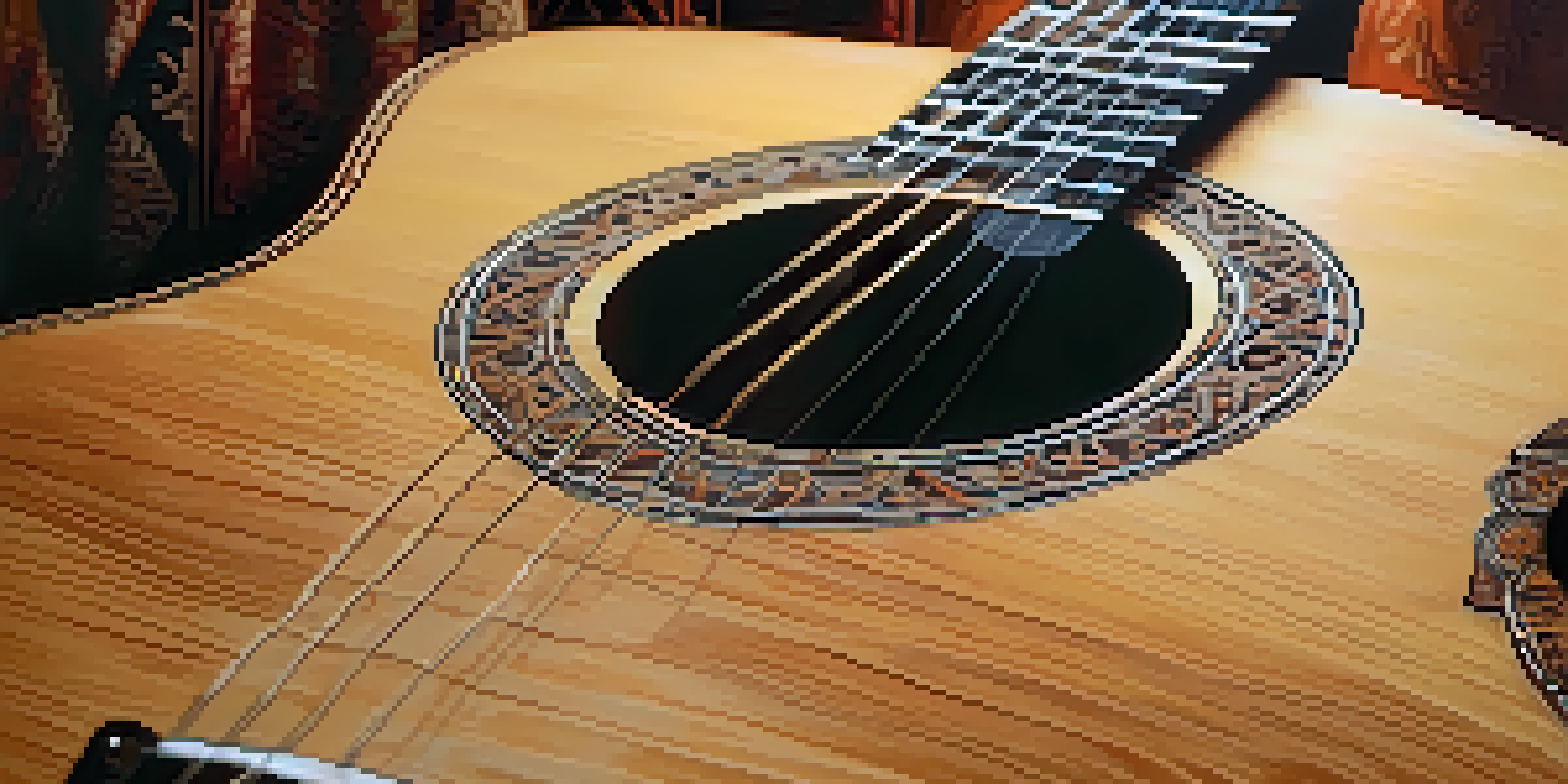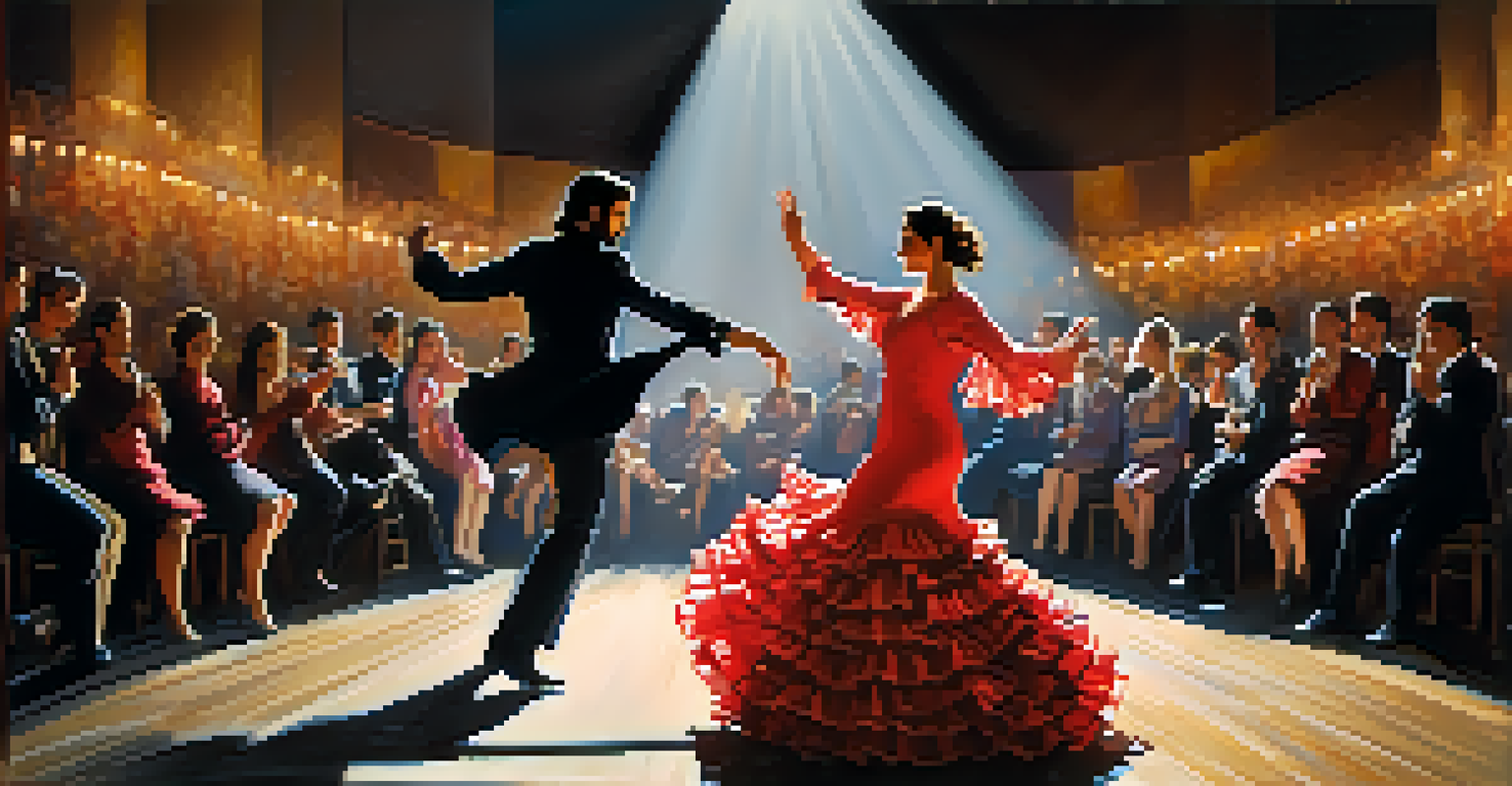The Influence of Spanish Guitar Techniques on Modern Styles

The Roots of Spanish Guitar: A Brief History
Spanish guitar has deep historical roots, tracing back to the 15th century. It evolved from earlier instruments like the lute and vihuela, gaining popularity in various regions of Spain. This rich history laid the groundwork for the unique techniques that would influence modern music genres.
The guitar is a miniature orchestra in itself.
The flamenco style is a standout, characterized by its passionate rhythms and intricate fingerpicking. This genre not only showcases the guitar but also integrates dance and vocal elements, making it a comprehensive art form. Its emotive qualities resonate with many modern musicians seeking to express deep feelings through their art.
As we look at the history of Spanish guitar, it becomes clear that its techniques are not just historical artifacts but living traditions that continue to inspire contemporary styles. The blend of cultural influences in Spain has created a tapestry of sounds that enriches modern music.
Key Techniques of Spanish Guitar Playing
Spanish guitar techniques include rasgueado, arpeggio, and picado, each offering musicians distinct ways to express their creativity. Rasgueado, with its rapid strumming, adds a percussive flair, while arpeggio allows for a more melodic flow, creating a dynamic listening experience. Picado involves quick, precise finger movements that produce a bright, articulate sound.

These techniques aren't just for traditional music; they've been adopted by guitarists across various genres. For example, rock and pop musicians often incorporate flamenco-style strumming to add an exotic twist to their songs. This cross-pollination of styles highlights the versatility and appeal of Spanish guitar methods.
Spanish Guitar's Rich History
Spanish guitar techniques have evolved from deep historical roots, influenced by earlier instruments, and continue to shape modern music.
Understanding these techniques can enrich a musician's skill set, allowing them to blend influences seamlessly. Musicians who master these methods often find themselves standing out in the crowded music landscape, captivating audiences with their unique sound.
Spanish Guitar Influences in Classical Music
The influence of Spanish guitar techniques is notably felt in classical music, where composers like Isaac Albéniz and Manuel de Falla have integrated these styles into their works. Their compositions often feature intricate fingerpicking and rich melodic lines that echo flamenco traditions. This fusion creates a distinct sound that draws listeners into a vibrant, emotional world.
Music is the universal language of mankind.
Classical guitarists today continue to explore these influences, often performing pieces that blend traditional Spanish techniques with classical forms. This not only showcases their technical skill but also pays homage to the roots of their instrument. The result is a captivating musical narrative that speaks to both historical reverence and modern innovation.
As students and enthusiasts delve into classical guitar, the Spanish techniques serve as a foundation for developing their own unique styles. This blend of tradition and personal expression is what keeps the art form alive and evolving.
The Role of Spanish Guitar in Flamenco Music
Flamenco music is perhaps the most iconic representation of Spanish guitar techniques. It combines guitar, singing, and dance, creating a lively performance that captivates audiences. The guitar serves as the backbone, providing both rhythm and melody, and its techniques are essential for conveying the genre's passionate spirit.
In flamenco, the guitarists use techniques like golpe, where they tap the body of the guitar, adding a percussive element that complements the footwork of dancers. This interplay between guitar and dance creates an immersive experience that draws the audience into the performance. It's a celebration of cultural heritage that's both visually and audibly stunning.
Techniques Enhance Musical Expression
Techniques like rasgueado and picado provide diverse ways for musicians to express creativity, enriching various music genres.
Today's flamenco guitarists often blend traditional techniques with modern influences, pushing the boundaries of the genre. This evolution keeps flamenco fresh and relevant, attracting new fans while honoring its rich history.
Modern Genres Borrowing from Spanish Guitar Styles
Today, many modern genres, including jazz, rock, and pop, draw inspiration from Spanish guitar techniques. Artists often infuse their songs with the rhythmic strumming and intricate fingerwork typical of flamenco and classical styles. This blending of genres creates a rich musical landscape that resonates with diverse audiences.
For instance, the Latin jazz movement has embraced Spanish guitar, using its techniques to create complex rhythms and melodies. Guitarists like Paco de Lucía have paved the way, inspiring countless musicians to explore these sounds in their compositions. As a result, Spanish guitar techniques have found their way into mainstream music, creating a fusion that feels both fresh and familiar.
This cross-genre borrowing speaks to the universal appeal of Spanish guitar techniques. Musicians are continually seeking new ways to express themselves, and the emotive quality of these methods provides a powerful tool for creativity.
The Global Appeal of Spanish Guitar Techniques
The allure of Spanish guitar techniques extends far beyond Spain's borders, captivating musicians worldwide. From Asia to the Americas, guitarists are experimenting with these methods, blending them with their own cultural influences. This global exchange of ideas has enriched the musical landscape, creating a vibrant tapestry of sounds.
Many music schools and online platforms now offer courses in Spanish guitar techniques, making them accessible to aspiring musicians everywhere. This increased interest has led to a resurgence of traditional styles, as well as innovative fusions that keep the music evolving. The internet allows guitarists to connect, share techniques, and inspire one another, fostering a worldwide community.
Global Influence of Spanish Guitar
The appeal of Spanish guitar techniques transcends borders, inspiring musicians worldwide and creating innovative fusions across genres.
As Spanish guitar techniques continue to influence and inspire, they remind us of music's power to transcend borders. The ongoing evolution of these methods ensures that they remain relevant and vibrant, inspiring future generations of musicians.
Conclusion: The Lasting Legacy of Spanish Guitar Techniques
In conclusion, the influence of Spanish guitar techniques on modern styles is profound and far-reaching. From classical to contemporary genres, these methods enrich musical expression, allowing artists to convey a wide range of emotions. The passion and intricacy inherent in these techniques have left an indelible mark on the music world.
As musicians continue to explore and innovate, the legacy of Spanish guitar will undoubtedly thrive. The techniques may evolve, but their essence—passion, rhythm, and melody—will remain a vital part of musical storytelling. This enduring influence ensures that Spanish guitar techniques will continue to inspire and captivate audiences for years to come.

Ultimately, whether you're a seasoned musician or an enthusiastic listener, embracing the beauty of Spanish guitar techniques can deepen your appreciation for music. So, the next time you hear those familiar strums, take a moment to reflect on the rich traditions and modern innovations that have shaped this timeless art form.